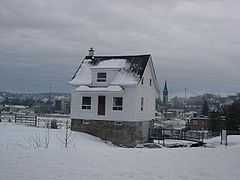Saguenay Flood
 The "little white house" in 2008. | |
| Date | July 19–20, 1996 |
|---|---|
| Location | Saguenay-Lac-Saint-Jean region of Quebec |
| Deaths | 10 |
| Property damage | CA$ $1.5 billion |
The Saguenay Flood (French: Déluge du Saguenay) was a series of flash floods that hit the Saguenay-Lac-Saint-Jean region of Quebec, Canada, on July 19 and 20, 1996. It was the biggest overland flood in 20th century Canadian history.
Problems started after two weeks of constant rain, which severely engorged soils, rivers and reservoirs. The Saguenay region is a geological graben, which increased the effect of the sudden massive rains of July 19, 1996. In the span of a few hours, 11 inches (280 mm) of rain fell on the region, the equivalent to the amount of rain usually received in a month.
Over 8 feet (2.4 m) of water ran through parts of Chicoutimi and La Baie, completely levelling an entire neighbourhood. Over 16,000 people were evacuated. The official death tolls were seven deaths, but other sources (notably Canadian Geographic[1]) cite ten. Estimates reach CAD $1.5 billion in damages, a cost made greater by the disaster's occurrence at the height of the tourist season. Post-flood enquiries discovered that the network of dikes and dams protecting the city was poorly maintained. In the end, 488 homes were destroyed, 1,230 damaged and 16,000 people evacuated from the entire area, with ten deaths in the mudslides produced by the incredible rain.[2]
A small white house (referred to in French as La petite maison blanche, "The little white house") that stood unharmed while torrents of water flowed around it became the symbol of the flood. It has been preserved as a historical park and museum commemorating the flood,[3] and despite a fire in 2002 remains standing today.
An unexpected effect of the flood was to cover the heavily contaminated sediments at the bottom of the Saguenay and Ha! Ha! Rivers with 10 to 50 centimetres (3.9 to 19.7 in) of new, relatively clean sediments. Research has shown that the old sediments are no longer a threat to ecosystems.[4]
Footnotes
- ↑ The Saguenay flood: After the deluge
- ↑ SOS! Canadian Disasters, a virtual museum exhibition at Library and Archives Canada
- ↑ La Petite maison blanche
- ↑ Project Saguenay
External links
- CBC Digital Archives - The Saguenay Flood
- Bilan du Siècle, University of Sherbrooke in (French)
- Meteorological Service of Canada: Top Ten Weather Stories of 1996
- Project Saguenay The scientific team doing research on the ecological effects of the flood.
Coordinates: 48°25′30″N 71°04′34″W / 48.42500°N 71.07611°W